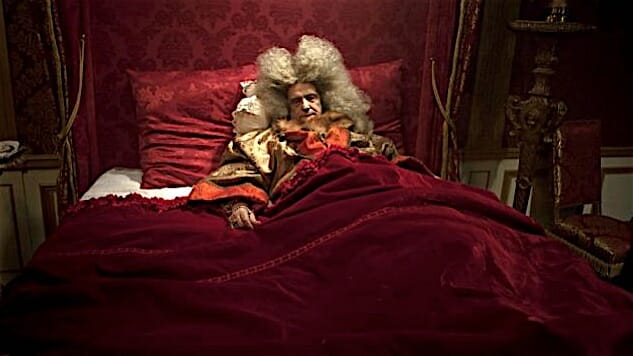
Two quick notes. First, Spanish auteur Albert Serra has a great eye. His latest film, The Death of Louis XIV, is cinematically brilliant. Painterly, in a hyperreal baroque still-life way, as if Caravaggio and Peter Greenaway had a lovechild. (Don’t linger on that concept for too long.)
Second, dying of gangrene is agony, and it takes a really damned long time.
Esthetically, The Death of Louis XIV is genius, and as mannered and opulent as the long, long reign of the Sun King himself. Nearly every shot is a painting by a European master—the gilding and the ripe fruit, the long-bodied hounds and the sumptuous linens and the mirrors and chiaroscuro candlescapes of Versailles. It’s absolutely beautiful in its decadence (and I mean that in the sense of luxury and the sense of decay, equally). Serra’s film has a certain dry wit in its depiction of the spectacle and ritual of the Louis XIV court, and a strong sense of elegiac portraiture.
That said, while I am all for taking a break from the relentlessly ADHD-paced, CGI-driven flit-fests that infest movie screens, for trying to slow the hell down for a few minutes as one observes delicate detail and mannered but kind of spectacular shot-by-shot rendering, well, holy crap. From the time Louis (played in a highly statuesque fashion by New Wave icon Jean-Pierre Léaud) fell ill in mid-August 1715, he lingered in a state of lassitude and fever and necrosis for about three weeks. The film runs two hours, and I swear it feels like you have also been dying of gangrene for three weeks by the time the credits finally roll.
The Death of Louis XIV is aptly titled: That is, pretty literally, the only thing that happens in this film. Once or twice we see a tiny glimpse of a character—Louis himself, in a fit of affection for his dogs, or one or two of the doctors who show a little of themselves in debates over “modern” medicine—but essentially this is a slideshow of a long, long, slow, painful, publicly observed death. That makes since, since Louis XIV had a famously public, observed life, and there is a kind of macabre anatomization of what that becomes when one’s decline is scrutinized in the same way. It’s nasty—two hours of palsied movements, heavy breathing, screams of pain and intermittent imperious demands as the king’s slowly necrotizing leg kills him a little at a time. At a meditative level there’s plenty to ponder: What must it be like to be such a public figure that you become the epitome of alone-in-a-crowd? What does it mean to die surrounded by quasi-worshippers and maybe no loved ones? Why the hell didn’t they amputate the freaking foot? (They knew it was gangrene.) What is your legacy worth when you’re rotting alive? It’s a meditation on mortality, on time running out, underscored either very cleverly or very ham-handedly by a soundtrack that consists almost exclusively of a ticking clock. Tick. Tock. Tick. Tock.
All of that is philosophically interesting, and Serra’s decision to focus on the final weeks of the achievement-rich, famously vivid life of a very famous person—during which he slowly disappeared and nothing, and I mean nothing else, apparently happened—is likewise interesting. Serra presents a film audience with a visually sumptuous but almost totally story-free film. It’s a masterful iteration of what it is: essentially a museum exhibit full of close-up portraits of the dying king and his attendants, complete with the long-nosed hounds and platters of grapes and crystal goblets of wine you’d find in period still-lifes. The dying king is beautifully disgusting; a willful, high-profile man of power reduced to a gasping, glassy-eyed zombie with food spilling from his mouth as his attendants attempt to feed him.
By 90 minutes in I found myself wanting to scream “Stop feeding him!” at the attendants and “Oh, please just stop breathing!” at the King. When the doctor finally said, “Le roi est mort,” I’m pretty sure I said “Oh, thank God,” out loud.
I’m not sure if that constitutes the viewer being challenged in a good way, or just asked to put up with way, way too much. We’re not in a museum. We’re watching a movie. They call them “movies” because they move. I admit it: while there was quite a bit to admire about its construction, I applauded at the end not because I was moved, but rather because the poor guy had finally been put out of his misery, and so had I.
Director: Albert Serra
Writer: Thierry Lounas, Albert Serra (screenplay)
Starring: Jean-Pierre Léaud, Patrick d’Assumçao, Marc Susini, Bernard Belin, Irène Silvagni
Release Date: March 31, 2017
Amy Glynn is a Super Famous Poet. Her interests include gardens, wines and non-gangrene-ridden monarchs. You can follow her on Twitter.